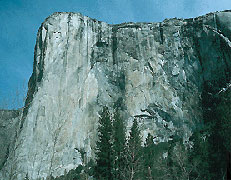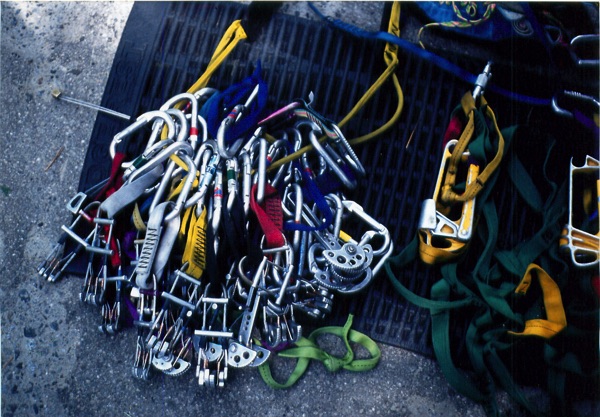

The Nose-in-a-day is quite likely the best one-day climb in the world. 3000 feet of excellent climbing, with pitch after pitch of exposure and adventure. The Nose route first went in a long day by the three-man team of John Long, Jim Bridwell, and Billy Westbay in 1975. Until around 1985, the Nose route on El Capitan had fewer than 10 one-day ascents (from the ground, no fixing). Now, as we approach the 20th anniversary of the first one-day ascent, it is routinely fired off in a day many times a season. Record holders Peter Croft, Hans Florine, and Dave Schultz have done it in less than 5 hours (in teams of two), simul-climbing much of the route. 5 hours is truly Olympic caliber. For mere mortals with a long rope, times of 10-12 hours are possible at a reasonable pace by a team of two fit 5.11 crack climbers, averaging 25-30 minutes a pitch.
After each pitch is led, the leader should fix the rope quickly so the second can jumar and clean as fast as possible. After the second cleans the pitch, he or she will then hand over the sharp end to the leader, and put the leader on belay. Meanwhile the leader reracks the cleaned gear and continues with the next lead. The whole process at each belay can be efficiently and safely done in less than a couple minutes.
The rope transfer during each a block are best facilitated if each climber is tied into the rope with two locking carabiners (instead of tieing the rope directly to the harness). It is quicker to switch ends of the rope since the rope the leader is tied into will be incorporated into the belay. The second will be attached to both jumars, which acts as his temporay belay as he gives up his end to the leader, and puts the leader on belay with it.. The belayer will clip into the leaders previous tie-in and the belay at his liesure (but before unclipping his jumars!!!).
At the end of each block, the second will jumar and clean as normal, then take over the lead. Block changeovers are best performed at spots on the route with a stance or ledge, where a short break can be taken.
Much of the climbing on the Nose is either free or "French- free", whereupon the golden rule of whatever's fastest and most energy efficient goes. A typical section will require running it out 10 to 20 feet on 5.10 ground, placing or clipping a piece, pulling past it, and continuing free climbing. A0 is the grade given to pulling on gear without aid ladders. The A1 on the route that is best done with aid ladders consists of 4 sections, none longer than 60 feet, and total about 200 feet for the entire route.
There are a lot of tricks to climbing fast, most of which can only be learned through experience. One of the main tricks is to climb with a 200 foot rope (although the first time I did it, with a 165' rope, Dave Schultz and I climbed it in 10 hours 44 minutes), and have the ability to go for it all day long. Tricks aside, the route requires a well coordinated effort between partners, with good communication skills to ensure a steady, safe, non-rushed, energy- efficient ascent. Watch for the simple traps like getting a rope stuck below or some dumb error like that.
Training routes(the hours in parenthesis are average fast times for these routes; actually, they are my times for these routes and will equate to about a 10 or 11 hour time for the Nose)
Good luck!

Nose-In-A-Day Rack, 1984